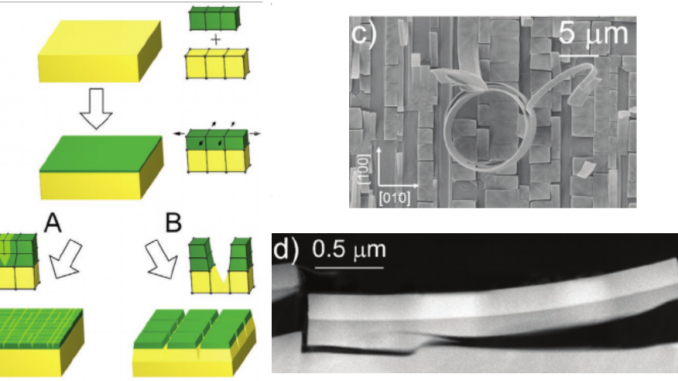
—
Alessia Sambri, Mario Scuderi, Anita Guarino, Emiliano Di Gennaro, Ricci Erlandsen Rasmus, T. Dahm Anders, V. Bjørlig, Dennis V. Christensen, Roberto Di Capua, Bartolomeo Della Ventura, Umberto Scotti di Uccio, Salvatore Mirabella, Giuseppe Nicotra, Corrado Spinella, Thomas S. Jespersen, Fabio Miletto Granozio. Self‐Formed, Conducting LaAlO3/SrTiO3 Micro‐Membranes, Advanced Functional Materials (2020). DOI: https://doi.org/10.1002/adfm.201909964
This paper introduces a method based on pure strain engineering to obtain freestanding LaAlO3/SrTiO3 membranes with micrometer lateral dimensions.
Abstract
The discovery of 2D conductivity at the LaAlO3/SrTiO3 interface has been linking, for over a decade, two of the major current research fields in materials science: correlated transition‐metal‐oxide systems and low‐dimensional systems. Notably, despite the 2D nature of the interfacial electron gas, the samples are 3D objects with thickness in the mm range. This prevented researchers so far from adopting strategies that are only viable for fully 2D materials, or from effectively exploiting degrees of freedom related to strain, strain gradient and curvature. Here a method based on pure strain engineering for obtaining freestanding LaAlO3/SrTiO3 membranes with micrometer lateral dimensions is demonstrated. Detailed transmission electron microscopy investigations show that the membranes are fully epitaxial and that their curvature results in a huge strain gradient, each layer showing a mixed compressive/tensile strain state. Electronic devices are fabricated by realizing ad hoc circuits for individual micro‐membranes transferred on silicon chips. The samples exhibit metallic conductivity and electrostatic field effect like 2D‐electron systems in bulk heterostructures. The results open a new path for adding oxide functionalities into semiconductor electronics, potentially allowing for ultra‐low voltage gating of a superconducting transistors, micromechanical control of the 2D electron gas mediated by ferroelectricity and flexoelectricity, and on‐chip straintronics.
—

Leave a Reply